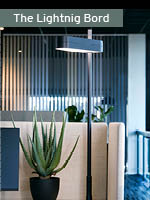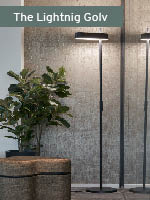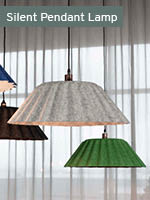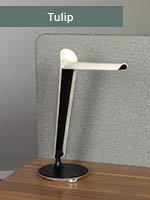



Poor lighting in the workplace and schools can lead to and contribute to ill health. A good work environment requires good lighting and is a condition for the human capacity to achieve good results at work and school. Lighting can be adapted to the work to be carried out. It should also be adapted to the need of the individual. At the office one can work sitting, standing, in groups, in conference rooms, or individual offices. This requires a well thought-out lighting solution in the room.
A glossary
General lighting – provides light that gives a good overview of a room and often consists of ceiling lamps.
Location or function lighting – lighting that facilitates for different tasks to be carried out in a particular area, for example when sitting at a desk and working.
Daylight – natural sunlight. Sweden has very little daylight during the autumn and winter months. If one is indoors that light comes through the windows.
Contrast – comes from a powerful light source and an unlit part, either the background or the light source.
Intensity – how much light comes from a light source and measured in Candela (cd).
Luminous flux – known as brightness in everyday speech, and indicates the amount of light produced by a light source. Luminous flux or brightness is measured in Lumen (lm).
Luminance – how much a surface is illuminated is measured in Lux (lx). The amount of lux does not determine if a room is well or badly illuminated.
Poor lighting can create physical discomfort. This is called poor visual ergonomics and can for example lead to tired eyes, headache, or tension in the back, shoulders and neck, where one moves the body to follow the light, or squint to be able to read. Contrasts between too much brightness, either from general lighting, spot lamps or the background, gives a visual overload that causes headaches and tension in the body. Flickering from lamps can cause stress reaction in the central nervous system, which contributes to fatigue and reduced performance. Not getting enough sunlight disturbs the body's sleep hormone levels causing a feeling of being closed in and isolated.
Common lighting problems in the workplace:
Insufficient lighting occurs primarily in office environments or classrooms with only general lighting. Insufficient lighting can cause people to not see sufficiently well to carry out their work tasks, giving rise to eye strain or poor posture. This problem is most easily rectified by supplementing the general lighting with individual location lighting.
Direct dazzling and reflections from luminaires and windows can be experienced as bright and cause headaches and burning in the eyes. This can be rectified by directing the light from lamps, awnings, blinds or other sunshades on the windows, and the positioning of the luminaires.
Different parts of the room need different amounts of light. Workstations with computer screens need light that doesn't dazzle or produce shadows, and the lights at the coffee machine or break table can be more subdued. There are legal standards for office lighting in Sweden. There must be a sufficiently high luminance within the reading field, evenly distributed work lighting, and an avoidance of disturbing reflections. Luminance should be adapted to the light of the surrounding areas and be regulated to individual preferences. The guidelines for workplaces are: 500 lux for an area the size of an A3 sheet of paper; 300 lux around the workstation itself; and 100 lux in the surrounding area.
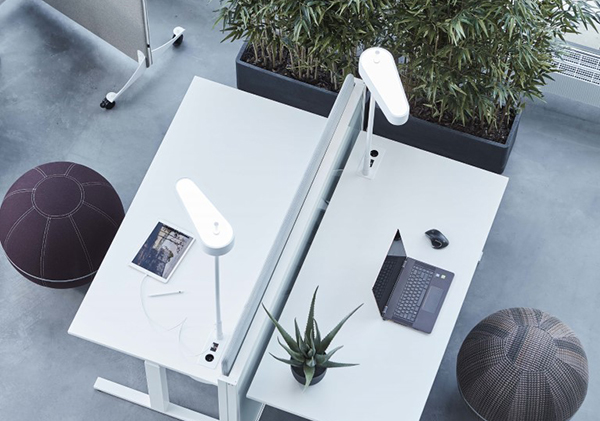
Ours tips for better lighting:
- Exposure to a lot of daylight – the more the better. Daylight reduces stress and depression, and improves sleep. However, getting enough sunlight during the winter can be problematic. Our tip is to go for a walk at lunchtime, and make the most of the light from the windows in the premises.
- Spot or function lighting must be used where there is a need – if one needs to read, write, sew or anything else that requires concentration. Too little lighting causes problems with legibility and detail. For example, desk lamps on the desk can solve this problem.
- Good general lighting is often based on ceiling lamps. Replace dazzling or flickering fluorescent lamps, direct spotlights at walls or objects, and install dimmers if it is possible.
- Direct any dazzling light sources that risk hitting the eye directly away, and create a balanced and softer light instead.
- It is important to think about the position of workstations in relation to windows. Windows as a background to workstations create contrasts, and having a window behind creates disturbing shadows.
- The need for light varies through the day. Lamps that can be adjusted for brightness is good for adapting the lighting to the environment and time of day. In the morning it may be more comfortable to have subdued lighting, brighter lighting in the middle of the day, and subdued lighting later in the day again.
- Rest your mind and eyes from screens and lighting during breaks, and allow your eyes to focus on something several metres away instead. Change location during the day if you can, to avoid sitting in the same light environment for too long.




